Planning of Electric Vehicle Charging Infrastructure for Urban Areas with Tight Land Supply
Abstract
:1. Introduction
- (1)
- A charging infrastructure load forecasting model is established. In the model, the sales volume of the fuel of gas stations in the planned area is converted into the quantity of charging electric energy by the notion of energy equivalence. Then the power is allocated to CCIs and DCIs located in different areas according to the equal product of load and distance (EPLD) criterion. This method has excellent feasibility because it is based on the data of current gas stations that are easy to get.
- (2)
- The means to determine the load capacity and check the whole planning scheme are proposed. Many important constraint conditions are considered including the different demands of EV consumers and the power utility.
- (3)
- The basic method to evaluate the planning scheme in terms of the economy and convenience is proposed, which is used to increase the satisfaction of consumers and obtain favorable investment income at the same time.
2. General Method for the Planning of Charging Infrastructures
2.1. Divisions of Charging Mode
2.2. The Flow of Charging Infrastructure Planning
- (1)
- Present status investigation and data collection. Here many kinds of data in the planned region should be collected such as vehicles, power network, traffic, geography, and so on.
- (2)
- Load prediction. Give an alternative scheme of locations of CCIs, and predict the amount of electric energy and the maximum loads of CCIs and DCIs.
- (3)
- Determination of the address and capacity. Based on the result of load prediction, determine all the addresses and capacity of CCIs and DCIs.
- (4)
- Checking the result scheme. Check the rationality of the result scheme and calculate its influence on the power network. Adjust the alternative scheme of locations of CCIs and re-implement step (2) and (3) until the result scheme reaches the demand.
- (5)
- Comprehensive evaluation. Here the economics and consumer convenience of the planning scheme are confirmed.
3. Choosing of Primary Scheme of CCIs
3.1. Traffic and Utilization Constraints
- (1)
- Charging demand constraint. A rough estimate must be done by the sales volume of fuel of the gas stations nearby (or by vehicle distribution or utilization data). The rate of charging stations must meet with a minimum demand level.
- (2)
- Traffic condition constraint. The optional locations of CCIs must be near the main road in the region so as to meet traffic convenience.
- (3)
- Constraint to overlay the service area. The service radius and area of the CCI are limited, and the combination of all the service areas should cover the planned district as much as possible.
- (4)
- Construction condition constraint. There must be enough land for the arrangement of parking space, charging devices, monitoring equipment, and office. Because many of these are concerned with the amount of charging load, this kind of constraint must be verified again after the prediction of charging load.
3.2. Constraints from Power Network
- (1)
- Supply source constraint. CCIs usually are supplied by 10 kV, and the supply source of it must have sufficient spare capacity and outlet interval.
- (2)
- Length constraint of distribution feeder. According to the standards of city distributed network, the length of the distribution line for CCIs should be 3–5 km, and it is unsuitable to be supplied by a source too far.
- (3)
- Power supply corridor constraint. Because of the increasing shortage of city land, the power supply corridor becomes one of the severe constraints in the charging infrastructure construction.
4. Load Prediction Based on Energy Equivalence
4.1. Computation of Equivalent Electric Quantity
4.2. Two-Stage Equivalent Electric Quantity Allocation Principle
4.3. Computation of Rigid Equivalent Electric Quantity
4.4. Computation of Flexible Equivalent Electric Quantity
4.4.1. Computation of Flexible Equivalent Electric Quantity at Centralized Charging Infrastructures
4.4.2. Computation of Flexible Equivalent Electric Quantity at Distributed Charging Infrastructures
5. Determination and Check of Result Scheme
5.1. Centralized Charging Infrastructures
5.2. Distributed Charging Infrastructures
6. Evaluation of the Planning Scheme
6.1. Economical Performance
6.2. Consumer Convenience
6.3. Effects on the Network’s Performance
7. Case Study
7.1. Basic Data
7.2. Results Analysis
- (1)
- Because CCIs have better construction conditions than DCIs, the CCR is far greater than the DCR during planning and design. So the FEEQ allocated to CCIs is much greater than that allocated to DCIs located in different areas, which makes CCIs the primary responsibility for public services and makes it beneficial to facilitate the operation business to obtain greater economic benefits by improving equipment utilization and management level.
- (2)
- The FFEQ of DCIs provides an emergency charging solution for EV users who cannot go to CCIs or a fault alternative for EV owners with personal charging equipment damage. Although the FEEQ of DCIs is low because of its function orientation, DCIs are indispensable for public services.
- (1)
- The maximum loads of CCIs are greater than that of DCIs because the high-power fast charging equipment is extensively used at CCIs. Besides, CCIs with better construction conditions can withstand greater peak loads. So, the result shown in Figure 9 is consistent with reality.
- (2)
- Because DCIs in the commercial area are limited in scale and have no REEQ, the maximum loads are low. In addition, the maximum load distribution of DCIs is uniform and not high, which is beneficial to reduce the impact of EV charging on the regional power grid.
8. Conclusions
Author Contributions
Funding
Conflicts of Interest
References
- Hannan, M.A.; Azidin, F.A.; Mohamed, A. Hybrid electric vehicles and their challenges: A review. Renew. Sustain. Energy Rev. 2014, 29, 135–150. [Google Scholar] [CrossRef]
- Parliament, E. Directive 2009/28/EC of the European Parliament and of the Council of 23 April 2009 on the promotion of the use of energy from renewable sources. Off. J. Eur. Union 2009, L120, 5–12. [Google Scholar]
- Rezvani, Z.; Jansson, J.; Bodin, J. Advances in consumer electric vehicle adoption research: A review and research agenda. Transp. Res. Part D Transp. Environ. 2015, 34, 122–136. [Google Scholar] [CrossRef]
- Rahman, I.; Vasant, P.M.; Singh, B.S.M.; Abdullah-Al-Wadud, M.; Adnan, N. Review of recent trends in optimization techniques for plug-in hybrid, and electric vehicle charging infrastructures. Renew Sustain. Energy Rev. 2016, 58, 1039–1047. [Google Scholar] [CrossRef]
- Chung, B.D.; Park, S.; Kwon, C. Equitable distribution of recharging stations for electric vehicles. Soc.-Econ. Plan. Sci. 2017, 63, 1–11. [Google Scholar] [CrossRef]
- Lam, A.Y.S.; Leung, Y.W.; Chu, X. Electric vehicle charging station placement. IEEE Trans. Smart Grid 2013, 5, 2846–2856. [Google Scholar] [CrossRef]
- Xiong, Y.; Gan, J.; An, B.; Miao, C.; Bazzan, A.L. Optimal Electric Vehicle Fast Charging Station Placement Based on Game Theoretical Framework. IEEE Trans. Intell. Transp. Syst. 2017, 99, 1–12. [Google Scholar] [CrossRef]
- Yang, J.; Hao, W.; Chen, L.; Jin, J.; Wang, F. Risk Assessment of Distribution Networks Considering the Charging-Discharging Behaviors of Electric Vehicles. Energies 2016, 9, 560. [Google Scholar] [CrossRef]
- Abdalrahman, A.; Zhuang, W. A Survey on PEV Charging Infrastructure: Impact Assessment and Planning. Energies 2017, 10, 1650. [Google Scholar] [CrossRef]
- Luo, C.; Huang, Y.F.; Gupta, V. Placement of EV Charging Stations—Balancing Benefits among Multiple Entities. IEEE Trans. Smart Grid 2018, 99, 1–10. [Google Scholar] [CrossRef]
- Boysen, N.; Briskorn, D.; Emde, S. Scheduling electric vehicles and locating charging stations on a path. J. Sched. 2018, 21, 111–126. [Google Scholar] [CrossRef]
- Zheng, Y.; Dong, Z.Y.; Xu, Y.; Meng, K.; Zhao, J.H.; Qiu, J. Electric Vehicle Battery Charging/Swap Stations in Distribution Systems: Comparison Study and Optimal Planning. IEEE Trans. Power Syst. 2013, 29, 221–229. [Google Scholar] [CrossRef]
- Wang, G.; Xu, Z.; Wen, F.; Wong, K.P. Traffic-Constrained Multiobjective Planning of Electric-Vehicle Charging Stations. IEEE Trans. Power Deliv. 2013, 28, 2363–2372. [Google Scholar] [CrossRef]
- Wang, S.; Dong, Z.Y.; Luo, F.; Meng, K.; Zhang, Y. Stochastic Collaborative Planning of Electric Vehicle Charging Stations and Power Distribution System. IEEE Trans. Ind. Inform. 2016, 14, 321–331. [Google Scholar] [CrossRef]
- Yao, W.; Zhao, J.; Wen, F.; Dong, Z.; Xue, Y.; Xu, Y.; Meng, K. A Multi-Objective Collaborative Planning Strategy for Integrated Power Distribution and Electric Vehicle Charging Systems. IEEE Trans. Power Syst. 2014, 29, 1811–1821. [Google Scholar] [CrossRef]
- Liu, Z.; Wen, F.; Ledwich, G. Optimal Planning of Electric-Vehicle Charging Stations in Distribution Systems. IEEE Trans. Power Del. 2012, 28, 102–110. [Google Scholar] [CrossRef]
- Colmenar-Santos, A.; Palacio, C.D.; Borge-Diez, D.; Monzón-Alejandro, O. Planning Minimum Interurban Fast Charging Infrastructure for Electric Vehicles: Methodology and Application to Spain. Energies 2014, 7, 1207–1229. [Google Scholar] [CrossRef] [Green Version]
- Bayram, I.S.; Tajer, A.; Abdallah, M.; Qaraqe, K. Capacity Planning Frameworks for Electric Vehicle Charging Stations with Multiclass Customers. IEEE Trans. Smart Grid 2015, 6, 1934–1943. [Google Scholar] [CrossRef]
- Chung, S.H.; Kwon, C. Multi-period planning for electric car charging station locations: A case of Korean Expressways. Eur. J. Oper. Res. 2015, 242, 677–687. [Google Scholar] [CrossRef] [Green Version]
- Wang, G.; Zhang, X.; Wang, H.; Peng, J.-C.; Jiang, H.; Liu, Y.; Wu, C.; Xu, Z.; Liu, W. Robust Planning of Electric Vehicle Charging Facilities with Advanced Evaluation Method. IEEE Trans. Ind. Inform. 2017, 14, 866–876. [Google Scholar] [CrossRef]
- Zhang, A.; Kang, J.E.; Kwon, C. Incorporating demand dynamics in multi-period capacitated fast-charging location planning for electric vehicles. Transp. Res. Part B Methodol. 2017, 103, 5–29. [Google Scholar] [CrossRef]
- Miceli, R.; Viola, F. Designing a Sustainable University Recharge Area for Electric Vehicles: Technical and Economic Analysis. Energies 2017, 10, 1604. [Google Scholar] [CrossRef]
- Shojaabadi, S.; Abapour, S.; Abapour, M.; Nahavandi, A. Optimal planning of plug-in hybrid electric vehicle charging station in distribution network considering demand response programs and uncertainties. IET Gener. Transm. Distrib. 2016, 10, 3330–3340. [Google Scholar] [CrossRef]
- Yin, X.; Zhao, X. Planning of Electric Vehicle Charging Station Based on Real Time Traffic Flow. In Proceedings of the 2016 IEEE Vehicle Power and Propulsion Conference, Hangzhou, China, 17–20 October 2016; pp. 1–4. [Google Scholar]
- Xie, F.; Liu, C.; Li, S.; Huang, Y. Long-term strategic planning of inter-city fast charging infrastructure for battery electric vehicles. Transp. Res. Part E Logist. Transp. Rev. 2018, 109, 261–276. [Google Scholar] [CrossRef]
- Wu, Y.; Xie, C.; Xu, C.; Li, F. A Decision Framework for Electric Vehicle Charging Station Site Selection for Residential Communities under an Intuitionistic Fuzzy Environment: A Case of Beijing. Energies 2017, 10, 1270. [Google Scholar] [CrossRef]
- He, F.; Yin, Y.; Zhou, J. Deploying public charging stations for electric vehicles on urban road networks. Transp. Res. Part C Emerg. Technol. 2015, 60, 227–240. [Google Scholar] [CrossRef]
- Dong, X.; Mu, Y.; Jia, H.; Wu, J.; Yu, X. Planning of Fast EV Charging Stations on a Round Freeway. IEEE Trans. Sustain. Energy 2016, 7, 1452–1461. [Google Scholar] [CrossRef]
- He, S.Y.; Kuo, Y.H.; Wu, D. Incorporating institutional and spatial factors in the selection of the optimal locations of public electric vehicle charging facilities: A case study of Beijing, China. Transp. Res. Part C Emerg. Technol. 2016, 67, 131–148. [Google Scholar] [CrossRef]
- Awasthi, A.; Venkitusamy, K.; Padmanaban, S.; Singh, A.K.; Raj, A.-D.-V.; Perumal, K.M. Optimal Planning of Electric Vehicle Charging Station at the Distribution System Using Hybrid Optimization Algorithm. Energy 2017, 133, 70–78. [Google Scholar] [CrossRef]
- Su, S.; Li, H.; Gao, D. Optimal Planning of Charging for Plug-In Electric Vehicles Focusing on Users’ Benefits. Energies 2017, 10, 952. [Google Scholar] [CrossRef]
- Clement-Nyns, K.; Haesen, E.; Driesen, J. The impact of charging pug-in hybrid electric vehicles on a residential distribution grid. IEEE Trans. Power Syst. 2010, 25, 371–380. [Google Scholar] [CrossRef] [Green Version]
- Staats, P.T.; Grady, W.M.; Arapostathis, A.; Thallam, R.S. A statistical analysis of the effect of electric vehicle battery charging on distribution system harmonic voltages. IEEE Trans. Power Deliv. 2010, 13, 640–646. [Google Scholar] [CrossRef]
- Wu, D.; Aliprantis, D.C.; Gkritza, K. Electric energy and power consumption by light-duty plug-in electric vehicles. IEEE Trans. Power Syst. 2011, 26, 738–746. [Google Scholar] [CrossRef]
- Hao, C.C.; Tang, Y.J.; Shi, J. Study on the Harmonic Impact of Large Scale Electric Vehicles to Grid. Appl. Mech. Mater. 2014, 443, 273–278. [Google Scholar] [CrossRef]

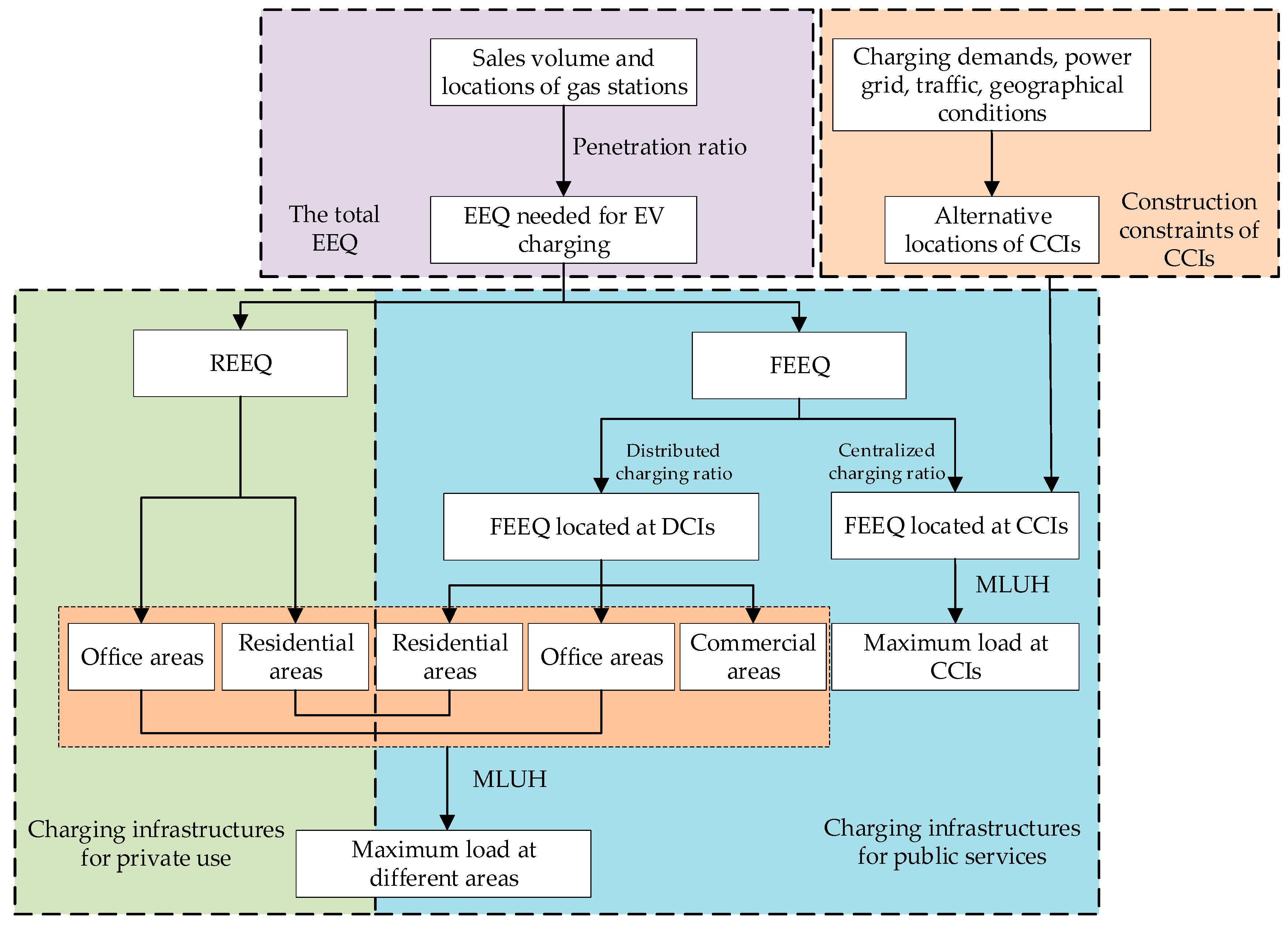
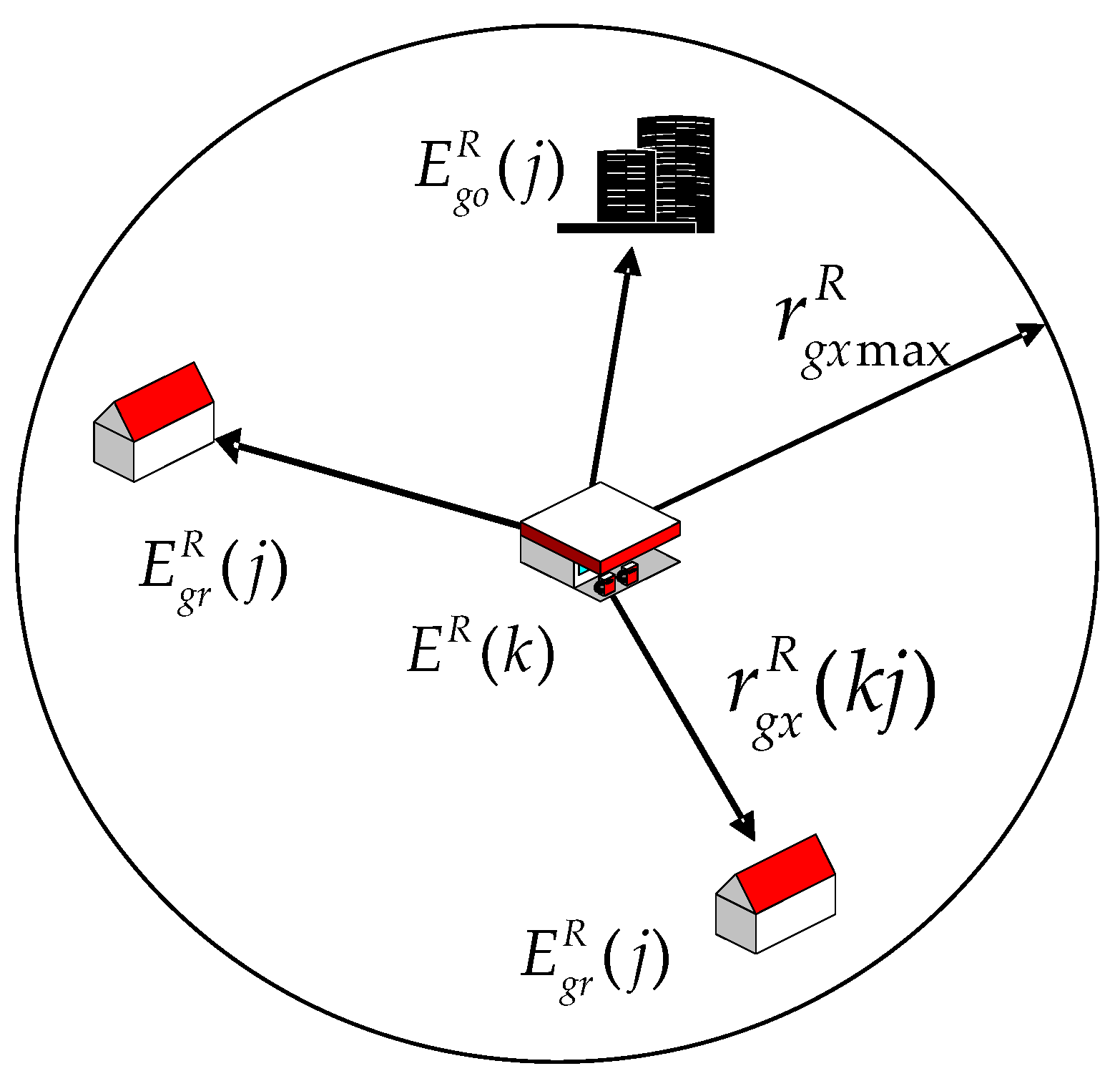
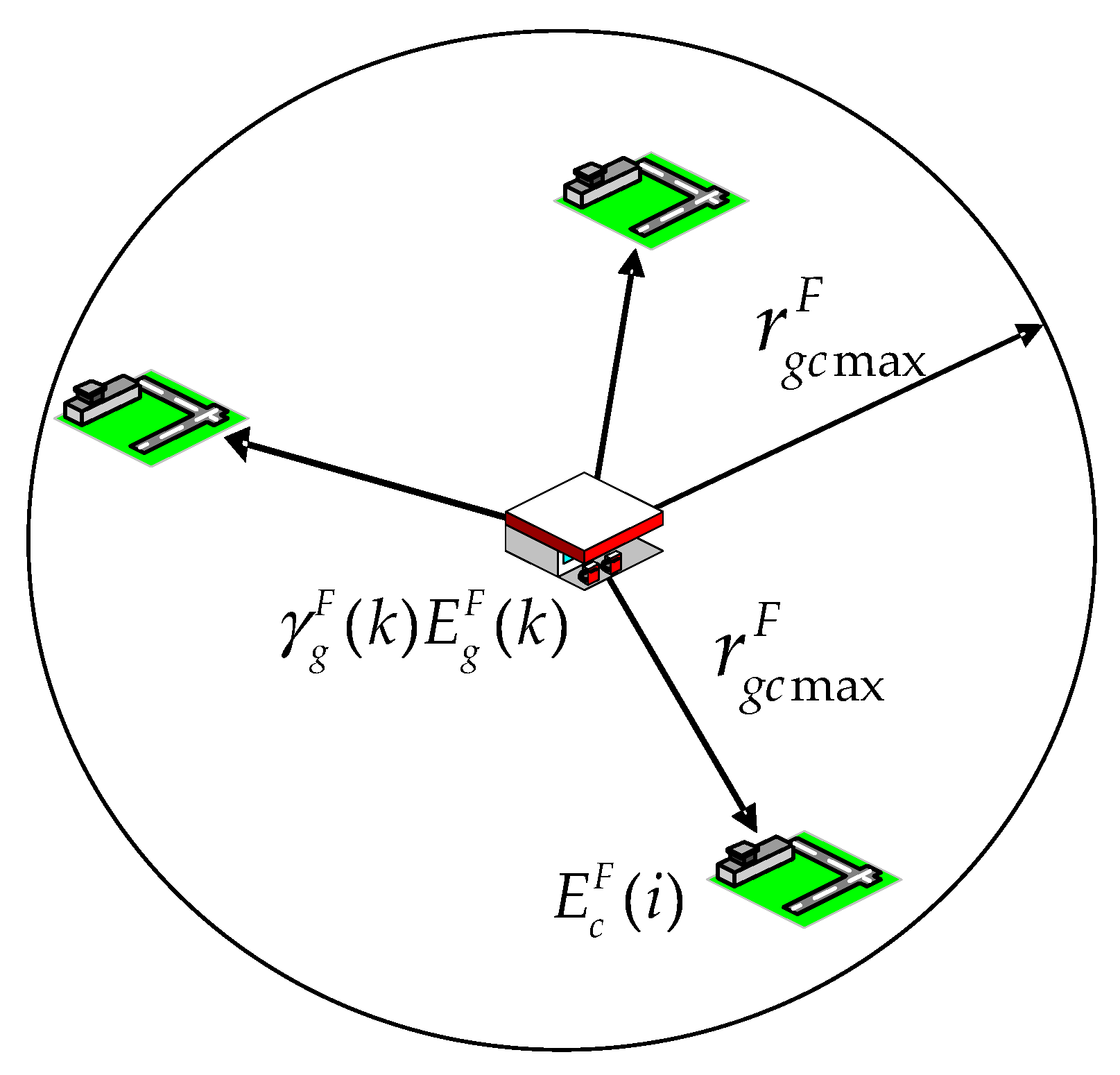
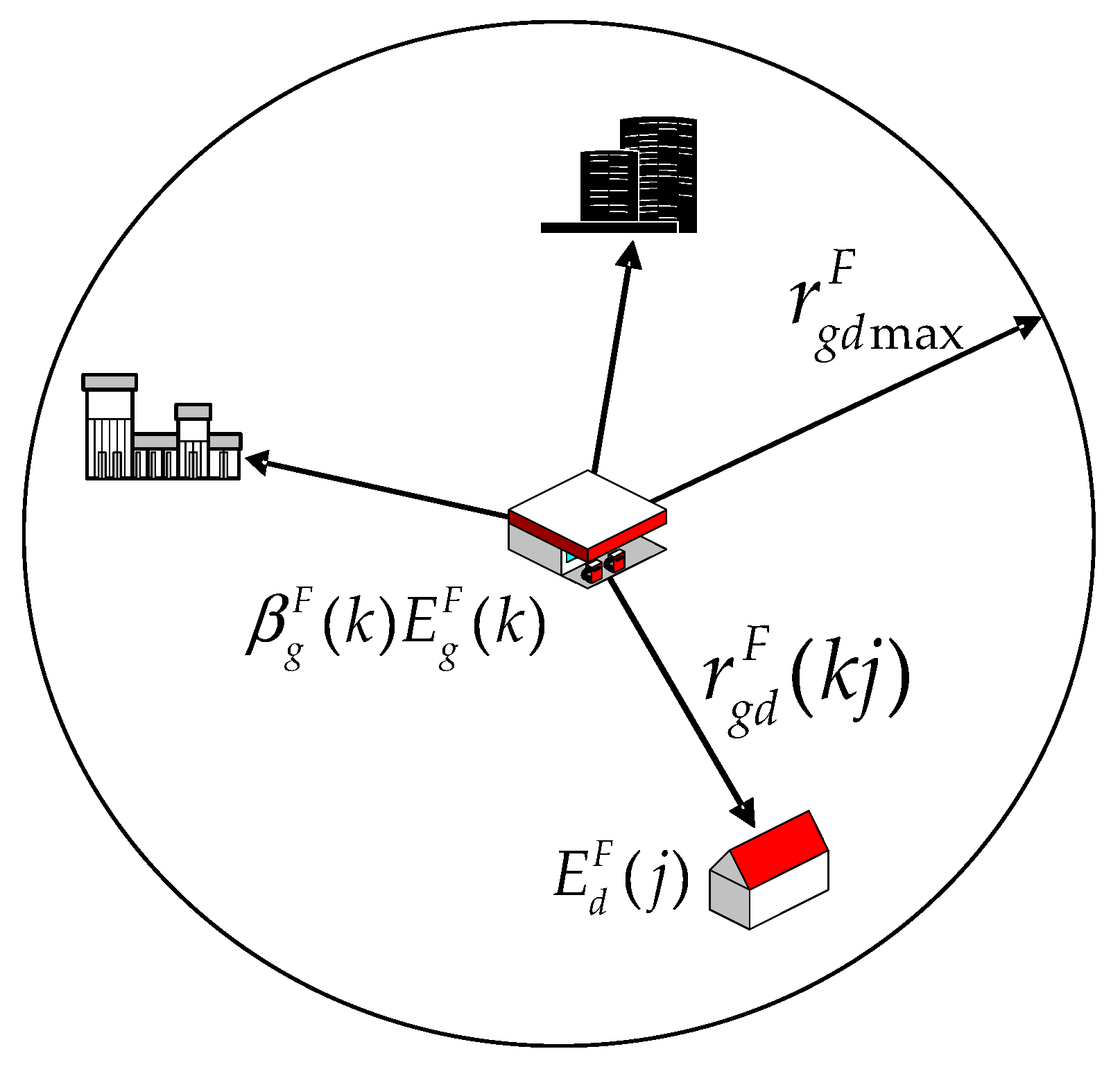


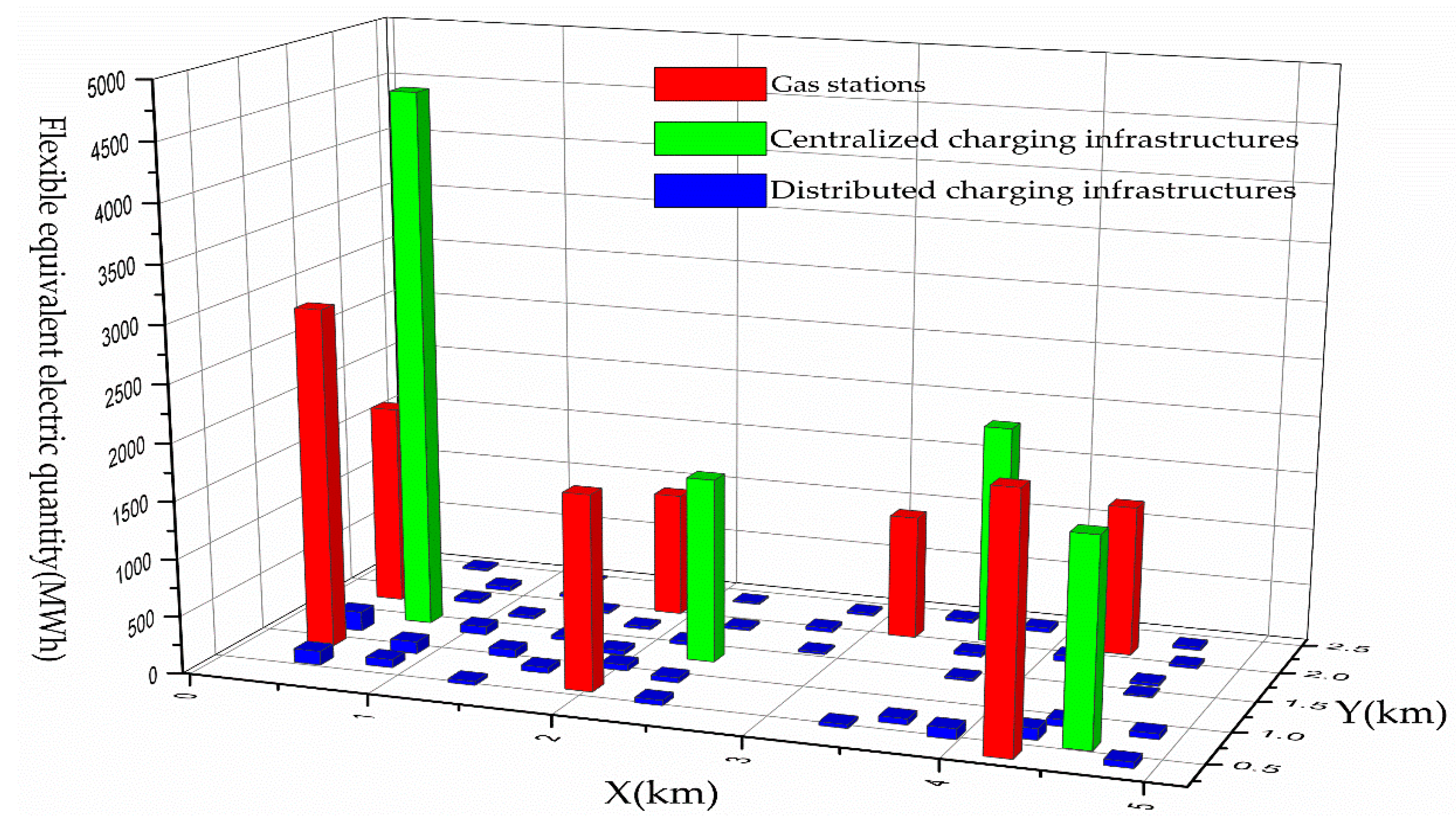

| Properties | [25] | [26] | [27] | [28] | This Paper |
|---|---|---|---|---|---|
| Planning area | Inter-city fast charging infrastructure | Residential communities | Urban road networks | Round freeway | Urban with tight land supply |
| Method of determining locations of CCIs | Genetic algorithm | Comprehensive EV charging station site selection decision framework | Tour-based equilibrium framework, genetic algorithm | Shared nearest neighbor (SNN) clustering algorithm | Give optional locations first and check constraints |
| Load forecasting method | Mixed integer programming model | None | None | Queuing theory | Energy equivalence method, equal product of load and distance criterion |
| Feasibility of parameter acquisition | Easy | Difficult | Easy | Difficult | Easy |
| Model Parameters | Value |
|---|---|
| K (kWh·(100 km)−1·T−1) | 10 |
| W (T) | 2 |
| H (L·(100 km)−1) | 8 |
| Unit conversion of fuel sales (L·T−1) | 1378 |
| (km) | 3 |
| (km) | 3 |
| (km) | 2 |
| (km) | 1 |
| Parameters | Penetration Ratio | CCR/DCR | DCI MLUH | CCI MLUH |
|---|---|---|---|---|
| Influence Factors | ||||
| Economy/income | △ △ | − | − | − |
| EV price | △ △ △ | − | − | − |
| Drive range | △ △ | △ | − | − |
| Regularity of use & charge | − | − | △ △ | △ △ |
| Charging price | △ | △ | − | − |
| Abundance of charging infrastructures | △ △ △ | △ △ △ | △ △ | △ △ |
| Coordinates (km) | Regional Type | Scale Factor | MLUH (h) | REEQ (kWh) | FEEQ (kWh) | Maximum Lode (kW) |
|---|---|---|---|---|---|---|
| (0.85,0.67) | R | 0.91 | 2659 | 444,643.45 | 72,150.32 | 194.36 |
| (0.40,1.20) | R | 0.98 | 2986 | 713,117.80 | 169,849.83 | 295.70 |
| (1.05,1.34) | R | 1.00 | 2290 | 488,028.03 | 73,183.07 | 245.07 |
| (0.77,1.85) | R | 0.89 | 2346 | 465,238.58 | 36,465.62 | 213.86 |
| (0.53,2.44) | R | 0.86 | 2155 | 319,634.10 | 22,725.55 | 158.87 |
| (1.27,2.12) | R | 0.94 | 2295 | 441,517.26 | 27,652.05 | 204.43 |
| (1.37,0.54) | R | 0.98 | 2170 | 467,117.57 | 34,608.37 | 231.21 |
| (2.20,2.34) | R | 1.12 | 2462 | 689,697.31 | 16,837.70 | 286.98 |
| (1.83,1.71) | R | 1.20 | 2998 | 878,445.83 | 24,528.93 | 301.19 |
| (2.16,1.52) | R | 0.95 | 2230 | 576,214.22 | 33,213.39 | 273.29 |
| (2.00,1.01) | R | 0.91 | 2150 | 579,726.01 | 52,300.58 | 293.97 |
| (2.85,2.34) | R | 1.10 | 2426 | 689,584.43 | 23,895.10 | 294.10 |
| (3.62,1.83) | R | 1.00 | 2173 | 593,022.67 | 35,520.46 | 289.25 |
| (4.17,2.34) | R | 0.88 | 2430 | 622,207.07 | 36,969.23 | 271.27 |
| (4.72,2.00) | R | 0.85 | 2364 | 431,430.77 | 24,951.32 | 193.06 |
| (4.63,1.47) | R | 0.89 | 2456 | 388,663.81 | 14,570.37 | 164.18 |
| (4.83,0.85) | R | 1.18 | 2487 | 425,649.67 | 49,392.17 | 191.01 |
| (3.91,0.53) | O | 1.14 | 2646 | 670,019.19 | 92,825.86 | 288.30 |
| (0.35,2.09) | O | 0.98 | 2303 | 548,846.95 | 58,993.70 | 263.93 |
| (1.21,2.42) | O | 0.95 | 2730 | 383,282.02 | 8499.01 | 143.51 |
| (1.17,1.69) | O | 0.96 | 2460 | 461,767.22 | 28,907.09 | 199.46 |
| (1.55,1.39) | O | 0.99 | 2363 | 570,672.06 | 33,959.61 | 255.87 |
| (2.33,1.87) | O | 1.00 | 2798 | 641,540.74 | 24,672.64 | 238.10 |
| (2.32,0.91) | O | 0.93 | 2486 | 547,983.13 | 45,223.29 | 238.62 |
| (2.38,0.55) | O | 0.90 | 2253 | 502,742.51 | 45,761.06 | 243.45 |
| (3.39,2.39) | O | 0.89 | 2660 | 521,511.99 | 32,235.41 | 208.18 |
| (3.71,1.43) | O | 0.91 | 2669 | 449,246.45 | 22,468.56 | 176.74 |
| (3.37,0.52) | O | 0.95 | 2356 | 387,664.96 | 33,507.98 | 178.77 |
| (4.28,0.65) | O | 0.96 | 2668 | 652,188.10 | 99,495.59 | 281.74 |
| (4.83,0.40) | O | 0.96 | 2286 | 376,894.97 | 53,517.77 | 188.28 |
| (4.66,2.31) | O | 0.93 | 2355 | 486,307.18 | 29,422.26 | 218.99 |
| (0.48,0.59) | O | 0.99 | 2575 | 540,775.57 | 121,501.55 | 257.19 |
| (1.63,0.84) | O | 0.94 | 2480 | 574,579.81 | 51,539.58 | 252.47 |
| (4.14,1.90) | O | 1.10 | 2853 | 777,569.41 | 54,135.20 | 291.52 |
| (0.82,2.13) | C | 1.30 | 1593 | 0.00 | 39,312.89 | 24.68 |
| (0.85,0.93) | C | 1.21 | 1786 | 0.00 | 106,364.31 | 59.55 |
| (1.76,2.33) | C | 1.10 | 1572 | 0.00 | 24,256.35 | 15.43 |
| (1.50,1.91) | C | 1.05 | 1493 | 0.00 | 18,529.70 | 12.41 |
| (1.36,1.03) | C | 0.99 | 1654 | 0.00 | 70,775.76 | 42.79 |
| (1.87,1.25) | C | 0.98 | 1663 | 0.00 | 42,237.50 | 25.40 |
| (2.75,1.98) | C | 1.20 | 1465 | 0.00 | 35,429.99 | 24.18 |
| (2.85,1.60) | C | 1.15 | 1523 | 0.00 | 20,286.15 | 13.32 |
| (3.83,2.36) | C | 1.16 | 1698 | 0.00 | 40,096.12 | 23.61 |
| (4.61,1.65) | C | 1.21 | 1598 | 0.00 | 26,215.95 | 16.41 |
| (4.41,0.89) | C | 1.08 | 1773 | 0.00 | 61,404.94 | 34.63 |
| (3.62,0.66) | C | 1.18 | 1653 | 0.00 | 52,977.30 | 32.05 |
| Coordinates (km) | Sale Volume (t·d−1) | Penetration Ratio | Rigid Factor | DCR | CCR |
|---|---|---|---|---|---|
| (0.39,0.91) | 28.56 | 15% | 45% | 18% | 82% |
| (0.33,1.79) | 23.78 | 12% | 51% | 14% | 86% |
| (1.97,0.64) | 24.19 | 13% | 57% | 20% | 80% |
| (1.86,2.04) | 21.54 | 16% | 75% | 15% | 85% |
| (3.19,2.03) | 22.73 | 14% | 73% | 15% | 85% |
| (4.26,0.34) | 30.12 | 13% | 55% | 20% | 80% |
| (4.34,2.12) | 22.44 | 15% | 69% | 18% | 82% |
| Coordinates (km) | MLUH (h) | FEEQ (kWh) | Maximum Load (kW) |
|---|---|---|---|
| (0.68,1.45) | 4576 | 4,680,899.21 | 1022.92 |
| (2.35,1.30) | 3705 | 1,607,062.38 | 433.76 |
| (3.66,2.11) | 4096 | 1,914,856.98 | 467.49 |
| (4.58,0.58) | 3682 | 1,786,537.75 | 485.21 |
© 2018 by the authors. Licensee MDPI, Basel, Switzerland. This article is an open access article distributed under the terms and conditions of the Creative Commons Attribution (CC BY) license (http://creativecommons.org/licenses/by/4.0/).
Share and Cite
Guo, C.; Yang, J.; Yang, L. Planning of Electric Vehicle Charging Infrastructure for Urban Areas with Tight Land Supply. Energies 2018, 11, 2314. https://doi.org/10.3390/en11092314
Guo C, Yang J, Yang L. Planning of Electric Vehicle Charging Infrastructure for Urban Areas with Tight Land Supply. Energies. 2018; 11(9):2314. https://doi.org/10.3390/en11092314
Chicago/Turabian StyleGuo, Chunlin, Jingjing Yang, and Lin Yang. 2018. "Planning of Electric Vehicle Charging Infrastructure for Urban Areas with Tight Land Supply" Energies 11, no. 9: 2314. https://doi.org/10.3390/en11092314




